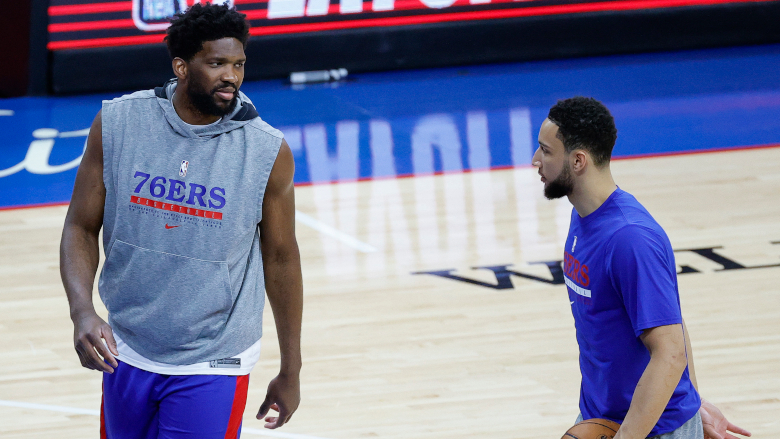
Getty Philadelphia 76ers stars Joel Embiid and Ben Simmons talk before a playoff game against the Washington Wizards.
On Sunday, the Philadelphia 76ers will move on to the next phase of their title chase when they tip off Game 1 of their second-round series with the Atlanta Hawks. Entering the contest, the status of Joel Embiid’s injured knee stands at the forefront of fans’ minds.
When will he play again? Will he play in the series at all?
At this juncture, the answers to those questions are anyone’s guess. All we know currently is that Embiid suffered a “small” lateral meniscus tear in his right knee. The Sixers further declared that he is day-to-day and that they will manage the injury with “a physical therapy and treatment program.”
While there is little to be gleaned from the team announcement, Philly Voice’s Kyle Neubeck interviewed a local medical expert in an effort to demystify the injury and provide some general information about meniscus tears.
The latest Sixers news straight to your inbox! Join the Heavy on Sixers newsletter here!
Doctor Breaks Down the Meniscus
Neubeck spoke with Dr. Mark Pollard at the Cooper University Health Care Bone and Joint Institute for his Thursday feature. Among other things, Pollard specializes in “the management and treatment of knee ligament and cartilage injuries.”
He broke down the meniscus and its functions as follows:
“Each knee has two menisci, a medial meniscus, and a lateral meniscus, and both of them generally function as shock absorbers and stabilizers,” he said. “We think their main function is actually absorbing force as you’re bearing weight on the knee.”
Pollard went on to explain that menisci move along with the knees, allowing them to better distribute that force. Moreover, they provide additional stability beyond that provided by the ligaments.
A World of Difference Between Tears
According to Pollard, the distinction that the Sixers gave that Embiid’s tear is of the smaller variety could be a big one.
“There’s kind of a world of difference here, no two tears are the same. You could have what is in essence a very tiny, small tear, where just a couple of millimeters are involved. In which case, it doesn’t involve a whole lot of the meniscus and it’s not a real structural problem, so the end result may be minimal,” he said.
Contrastingly, a larger tear could be devastating to the point that it renders the meniscus “incompetent.”
The doctor further relayed that a large tear can become a career-ender for “high-end athletes.”
Can He Play Through It?
The big question for Embiid and the Sixers is whether the injury will be one that he can play through. Given his day-to-day tag and the team’s announced treatment plan, that would seem to be the objective, which stands to reason given all that is at stake for the franchise this postseason.
Philly entered the playoffs with the No. 1 seed in the Eastern Conference for the first time in 20 years last month. In their previous stint as the top-seeded club, the Allen Iverson-led Sixers advanced to the 2001 NBA Finals. AI aside, the current club looks better equipped than that one was to come out on top against a strong Western Conference foe.
So while Embiid’s past injury history and future well-being must be considered, so too must his importance to the Sixers’ very real championship ambitions.
To that end, there may be some good news for Sixers fans.
Although he was speaking in generalities as opposed to addressing Embiid’s case specifically, Pollard noted that it could be possible to play through a small tear.
“If the tear doesn’t involve, for example, an unstable flap — a piece of the meniscus that can actually flip and get stuck in the wrong spot — and if it’s in a location that’s unlikely to propagate and get bigger, then it’s possible to go on without actually doing anything for it,” he said.
“There’s probably many athletes who have some small meniscus tears and don’t even know it because they’re not very symptomatic.”
READ NEXT: Joel Embiid Explains ‘Thrusting the Process’
